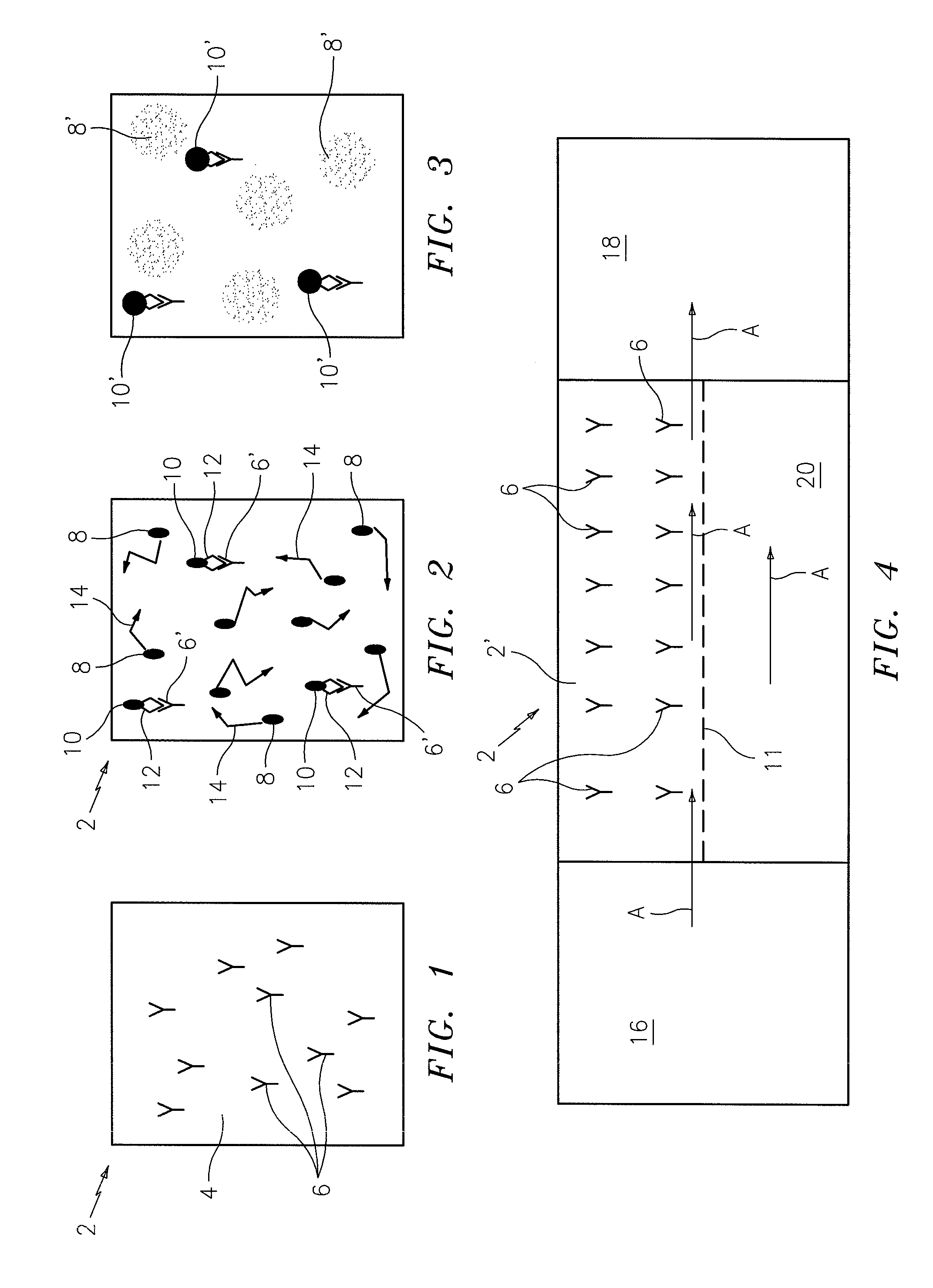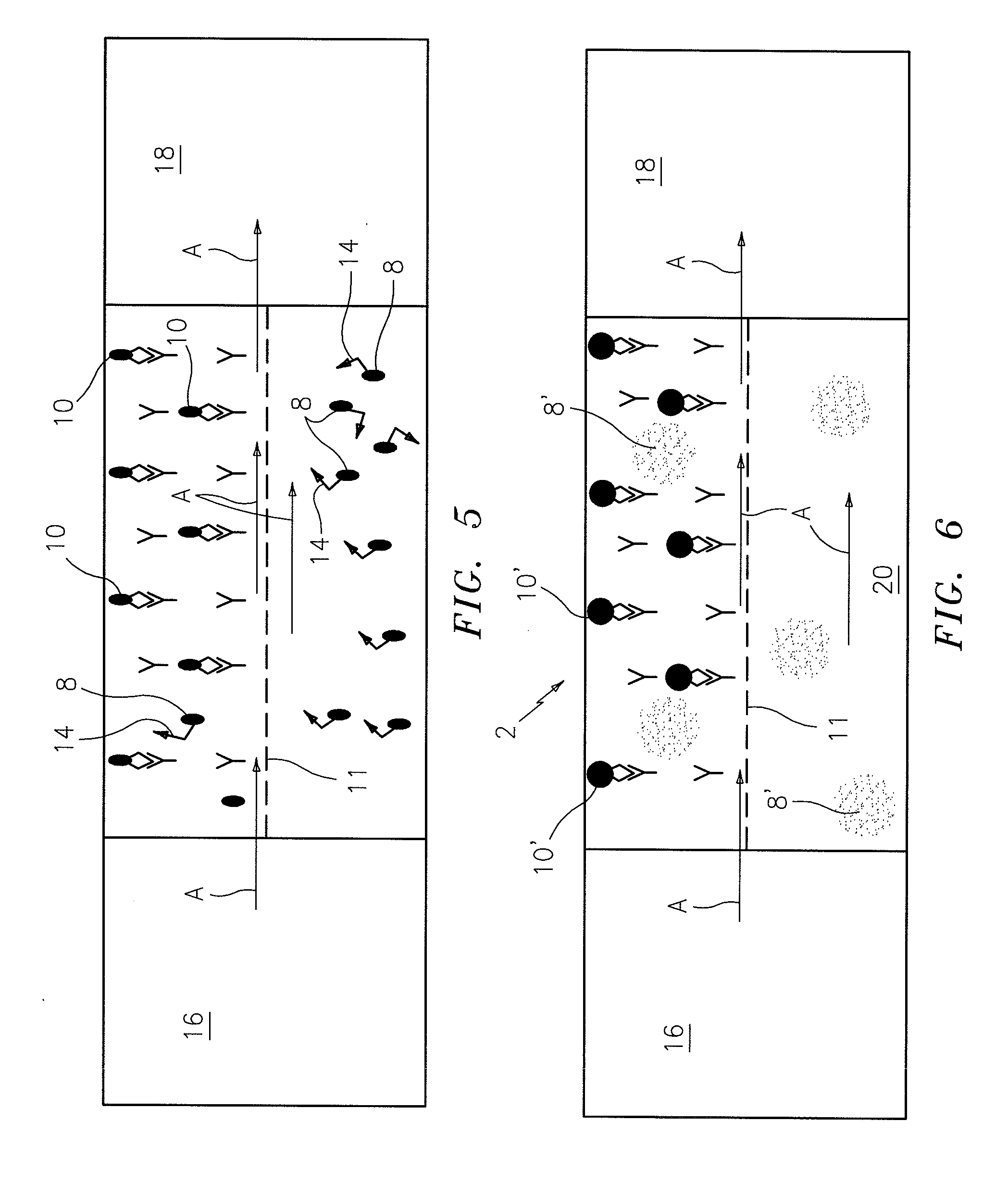[0008]The
blood plasma or serum sample is added to the chamber, and all of the TSH molecules in the sample will bind to the immobile substrate containing the capture antibodies, thereby immobilizing all of the molecules present in the sample. The thin (typically less then ten microns (10μ)) chamber thickness allows rapid vertical
molecular diffusion so that the
diffusion between the two
layers of the thin chamber occurs rapidly, allowing all the molecules of the analyte to contact the
capture antibody surface. Ideally, the
plasma, or other
biological fluid being examined, should be clear and free of particles such as cells that might interfere with the binding of analyte or the detection of
signal in the
assay.
[0010]A single fluorescent
nanoparticle containing an
antibody / ligand directed against the second
epitope of the TSH analytes will attach to each TSH molecule that is bound to the substrate. Those
fluorescent nanoparticles that are not immobilized by virtue of their attachment to the immobilized analyte will continue to be in colloidal suspension and move due to
Brownian motion. To distinguish bound nanoparticles from unbound nanoparticles, the
test chamber is imaged under appropriate fluorescent illumination, in the focal plane of the bound particles, after incubation for a period of time which is long enough to give a measurable rise in
signal due to the immobile light emitting nanoparticles, as compared to the emission of the moving light emitting nanoparticles which will cause
background light due to unbound
signal generating nanoparticles. This time of
exposure may be adaptively determined by the
measuring instrument but limited in its upper extent since it is possible that the areas may have no bound nanoparticles. Those nanoparticles which remain in one location because they are fixed to the substrate will put all of their photons into just a few pixels, while those which “dance” around due to
Brownian motion will distribute their brightness over a much larger area, thereby making the detection of the immobile particles possible. A surface area of the chamber which is free of capture antibodies can serve as the
control area.
[0011]Using this technique, the concentration of nanoparticles in the imaged area should be small enough so that they do not completely overlap and diminish the ability of the sensor to distinguish the immobile particles. The number of individual distinguishable immobile fluorescent particles is therefore equal to the number of molecules of the target analyte contained in the volume of the chamber above or below the capture antibodies within the capture area. Since the volume of the fluid above the
control area is relatively small compared to the volume above the immobilized
capture antibody or ligand, it may be ignored for purposes of calculating the total volume of the chamber or narrow passage, acting as a
diffusion barrier separating the
control area from the capture area which may be used to obtain an exact chamber volume over the capture area. Alternatively, an actual impermeable barrier may be employed to separate the capture area from the control area. The maximum number of molecules that may be measured in the contained sample is defined by the capture area of the chamber and the pixel
magnification. The concentration of the target analyte will be the number of molecules detected divided by the sample contents in the chamber above the capture area. The volume of the chamber is defined by the known height of the chamber and the area of the sample, which may be defined by the number of pixels within the
sample area and the area / pixel
magnification factor. Therefore, if the chamber height and
magnification are known, the amount of
sample volume may also be determined by the instrument performing the analysis. It is necessary that the bound molecules be bound a sufficient distance from each other so that
coincidence of signal from the captured labeled nanoparticles avoided. For example, if the
fluorescence of a signal contained on a
nanoparticle can be detected over an area of 3 to 10 pixels, and the desired
image separation of the nanoparticles is at least twice that distance, or about 15 pixels apart, with a magnification yielding an image size of 0.5 microns / pixel, a one square cm of
sample area would contain enough resolution for the detection of maximum of about one to two million molecules per chamber. The
lower limit of the amount of molecules detected in the chamber is in theory, one, limited of course, by counting statistics. It will be appreciated by one skilled in the art that the thinner the chamber, the greater the discrimination between bound from free labeled target analyte ligand, but the smaller the volume of the sample contained in the chamber. The larger the area of the chamber, the greater the
dynamic range, but the longer the time needed to obtain the images of the chamber for analysis.
 Login to View More
Login to View More  Login to View More
Login to View More 


